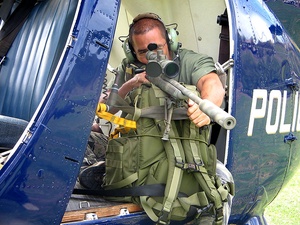Bringing police secrecy to light in Ferguson

While last night’s protests over the killing of Michael Brown seemed like a cool breeze over a still searing wound, it will be a long time before people can forget the images of the night before. Images of an utterly militarized police force, of snipers looking over a peaceful protesters, of tanks rolling through the American suburbs. Indeed, these should not be forgotten.
Neither should the government’s various decisions — good and bad — be forgotten.
Below are three categories where the authorities involved utterly failed in their duty to be transparent. Unfortunately, they reflect broader problems across America.
1. Withholding of information
The Ferguson police department initially withheld the name of the officer who shot Michael Brown based on what they identified as potential danger to the officer. While many have questioned the police department’s decision, the statutory ability of police departments to withhold their records from the public does vary substantially from state to state. In this case, Missouri law permits police records to be closed to the public if they are “reasonably likely to pose a clear and present danger to the safety of any victim, witness, undercover officer, or other person.”
Now that the police department has decided to release the name of the officer, the public can finally find out more about his history and begin to understand how Brown’s killing fits into a broader pattern of events. This was useful for us to begin to better to understand what happened in New York, where a police officer killed Eric Garner through use of an outlawed choke-hold. With information about the identities of the officers involved in the New York death, we were able to learn that one of the implicated officers was the subject of two separate civil rights lawsuits. One settled for $30,000, and the other is still open. Meanwhile, now that we have the name of the Ferguson officer we can also learn the context of this police killing. In this case, we’ve learned that Darren Wilson did not have a record of disciplinary actions, but the Ferguson police department itself is increasingly being revealed as a site where major violations of oversight mechanisms may have occurred.
The power to decide whether to withhold or release names in connection with police action is a substantial power to entrust to state and local governments and agencies. It can be used to protect individual police officers while focusing public attention at civilians. In the way that it was used in Ferguson there was more than a tinge of a double standard, given how quickly the police department announced the names and ages — as young as 19 — of alleged looters in Ferguson.
2. Suppression of media
One of the most insidious attacks on transparency is the obscuring of the public lens. It removes the public’s ability to scrutinize the activities of government — especially alarming when those activities include lethal force. It is devastating to all sides of the national discourse, because it insulates us from new evidence. If one assumes the police are terrorizing citizens, stories will be viewed thus. Ditto if one assumes the protesters are crossing lines and ultimately forcing police action.
This is what makes the Ferguson police department’s tear-gassing of an Al Jazeera America news team and subsequent manipulation of their film equipment so disturbing. Fortunately, a local news team at KSDK caught it on camera. In what can only be described as an offline version of the Streisand effect, the video has since gone viral with over 17,000 shares of KSDK’s article alone.
3. Opaque policies and police militarization
“Will I get tear-gassed again?” That question isn’t from a rioter — it’s from Missouri state Sen. Maria Chappelle-Nadal. Ferguson police chief’s only response: “I hope not.”
Other questions worth asking: When is tear gas authorized? What makes a protest “violent?” Where the hell did you get sniper rifles and armored trucks? And why would a town of just over 20,000 people want it?
We know some of the causes to this militarization, including a variety of federal policies that have funded police acquisition of military-grade equipment, but how many residents of Ferguson knew that their police force were as well or better armed than servicemembers in Iraq? How many Bostonians expected a similar police turnout after the Boston Marathon bombing? And does anyone know what triggers this use of force?
Terrifyingly enough, Americans should expect this problem to get much worse before it gets better. One federal program has transferred over $4.3 billion to local law enforcement agencies — half a billion in 2013 alone. That’s equipment that’s already flowed through the pipe, and a small minority of it went to Ferguson.
Amid all this, there is one thing we thankfully don’t know: How many people would this under-trained, armed-to-the-teeth police militia have killed if a rioter had arrived with similar zeal, or fired a bullet instead of throwing a bottle? And can we know how many people are killed by police every year?
There will be an increasing number of criticisms and questions about Ferguson, Missouri, weighted heavily toward law enforcement. But there is one that recurs to me with every news update: How did we get here? And what competent police force could possibly endorse this activity? And who signs off on these policies?
After Ferguson, it’s increasingly clear that the answer to the last question is “Not us.”
Fortunately, among the ACLU, KSDK and to the long-overdue national alarm about police militarization, we’re on the path to more answers. Hopefully we can learn from them quickly.

